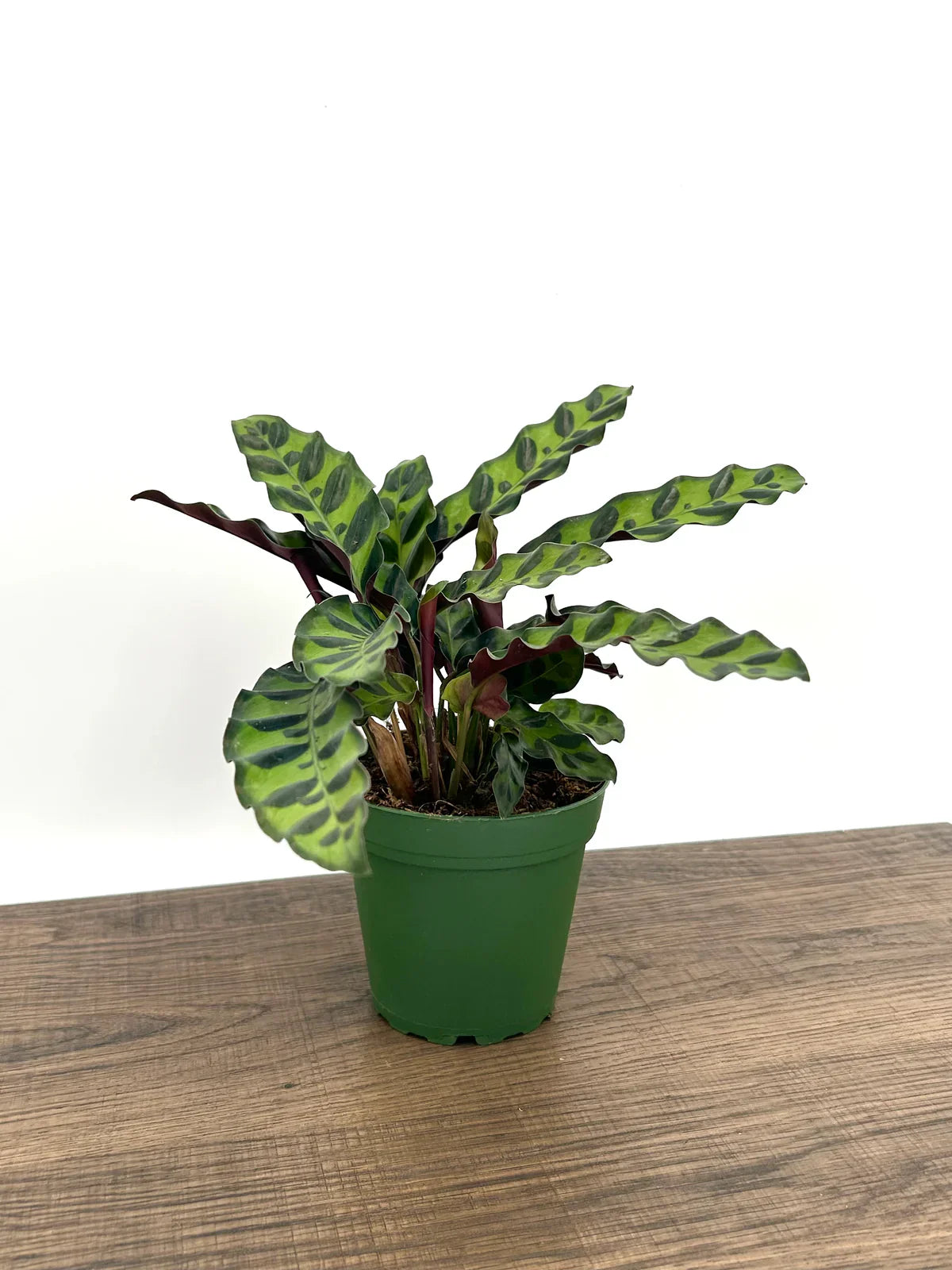Know Your Rattlesnake Plant
The Rattlesnake Plant (Calathea lancifolia) is a stunning and popular houseplant that captures attention with its distinctive foliage and unique behavior. Named for the wavy patterns on its long, lance-shaped leaves, which resemble the skin of a rattlesnake, this plant adds a touch of exotic beauty to any indoor space. Its leaves are marked with dark green, elliptical spots against a lighter green background, and the undersides are a rich, deep purple. This striking combination makes it a favorite among plant enthusiasts. Native to the tropical rainforests of Brazil, the Rattlesnake Plant thrives in environments that mimic its natural habitat. It prefers warm, humid conditions with consistent moisture, which can be a challenge to replicate indoors but is essential for the plant's health and vibrant appearance.
Watering Requirements
Proper watering is crucial for the health and vibrancy of the Rattlesnake Plant. Here are detailed guidelines to ensure your plant receives the right amount of moisture:
Consistent Moisture
- Regular Watering: The Rattlesnake Plant thrives in consistently moist soil. Water the plant regularly, but avoid waterlogging. Overwatering can lead to root rot, which is detrimental to the plant’s health.
- Checking Soil Moisture: To determine if your plant needs watering, check the top inch of the soil. If it feels dry to the touch, it’s time to water. If it’s still moist, wait a few days before checking again.
Watering Technique
- Even Moisture Distribution: Water the plant evenly around the base, ensuring all parts of the root system receive moisture. Avoid watering directly onto the leaves to prevent fungal issues.
- Drainage: Ensure the pot has good drainage to prevent water from accumulating at the bottom. Use pots with drainage holes and consider placing a saucer underneath to catch excess water.
Water Quality
- Filtered or Distilled Water: Rattlesnake Plants are sensitive to chemicals commonly found in tap water, such as chlorine and fluoride. Using filtered or distilled water helps prevent leaf browning and other chemical damage.
- Room Temperature Water: Always use water at room temperature. Cold water can shock the roots, while hot water can damage them.
Humidity
- High Humidity Requirement: The Rattlesnake Plant naturally thrives in humid environments. To mimic its native conditions, maintain high humidity levels around the plant.
- Misting: Regularly mist the leaves with distilled or filtered water to increase humidity and prevent the edges from browning. However, avoid over-misting, as this can lead to fungal issues.
- Humidity Trays: Place a humidity tray (a shallow tray filled with water and pebbles) under the plant. As the water evaporates, it increases the humidity around the plant.
- Humidifier: Using a humidifier in the room can also help maintain consistent humidity levels, especially in dry indoor environments.

Shop Calatheas From Happy Plant
Light Requirements
Providing the right light conditions is essential for the Rattlesnake Plant (Calathea lancifolia) to thrive. Here’s a detailed guide on meeting its light needs:
Bright, Indirect Light
- Optimal Light: The Rattlesnake Plant flourishes in bright, indirect light. Place the plant near a window where it can receive filtered sunlight throughout the day. An east-facing window is ideal as it provides gentle morning light.
- Avoid Direct Sunlight: Direct sunlight can be too harsh, causing the leaves to scorch, fade, or develop brown spots. Use sheer curtains or blinds to diffuse the light if the plant is in a sunnier spot.
Low Light Tolerance
- Adapting to Lower Light: While the Rattlesnake Plant prefers bright, indirect light, it can tolerate lower light conditions. In low light, the plant may grow more slowly, and the vibrancy of its foliage might diminish slightly.
- Supplemental Lighting: In rooms with insufficient natural light, consider using artificial grow lights. LED grow lights can provide the necessary light spectrum for healthy growth. Position the grow lights about 12-18 inches above the plant and use them for about 12-14 hours a day.
Seasonal Light Adjustments
- Summer Light: During the summer months, when daylight is more intense, be particularly cautious about exposing the plant to direct sunlight. Ensure it remains in a shaded area or receives filtered light to avoid leaf burn.
- Winter Light: In the winter, when natural light levels are lower, you may need to move the plant closer to a light source or increase the duration of artificial lighting to maintain its health.
Signs of Inadequate Light
- Insufficient Light: If the plant is not receiving enough light, it may show signs such as slow growth, smaller leaves, and less vibrant coloration. The leaves might also start to droop.
- Excessive Light: Signs of too much light include scorched leaf edges, faded colors, and brown spots. If you notice these symptoms, move the plant to a less intense light area immediately.
Rotating the Plant
- Even Light Exposure: To ensure uniform growth, rotate the plant every few weeks. This prevents the plant from leaning towards the light source and promotes even leaf development.
Light and Leaf Movement
- Nyctinastic Movement: The Rattlesnake Plant’s leaves move in response to the light cycle. During the day, leaves spread out to maximize light absorption. At night, they fold upwards. This movement is normal and indicates the plant is responding well to its light environment.

Soil Requirements
Well-Draining Soil
- Importance of Drainage: Rattlesnake Plants require soil that retains moisture but also drains well. Poor drainage can lead to waterlogging and root rot, which are detrimental to the plant's health.
-
Soil Composition:Use a potting mix that includes components like peat, perlite, and orchid bark to ensure good drainage. A typical mix might be:
- 1 part peat moss or coco coir (for moisture retention)
- 1 part perlite or coarse sand (for drainage)
- 1 part potting soil or compost (for nutrients)
- A small amount of orchid bark (optional, for additional aeration)
Ph Level
- Optimal pH Range: The Rattlesnake Plant prefers slightly acidic to neutral soil, with a pH range of 6.0 to 7.0. Most commercial potting mixes fall within this range.
Soil Amendments
- Improving Drainage: If you notice that your soil is not draining well enough, you can amend it by adding more perlite or coarse sand. These amendments help increase aeration and prevent compaction.
- Nutrient Boost: Occasionally, you can top-dress the soil with organic matter, such as compost or well-rotted manure, to provide a slow-release nutrient boost. This can be particularly beneficial during the growing season (spring and summer).
Repotting
- Frequency: Repot your Rattlesnake Plant every 1-2 years or when it becomes root-bound. Signs of being root-bound include roots growing out of the drainage holes or circling the inside of the pot.
- Pot Size: When repotting, choose a pot that is 1-2 inches larger in diameter than the current one. Ensure the new pot has drainage holes to prevent water from sitting at the bottom.
Planting Depth
- Correct Planting Depth: When repotting or planting, ensure the plant sits at the same depth it was previously growing. Planting too deep can lead to stem rot, while planting too shallow can expose the roots.
Mulching
- Mulch Layer: Applying a thin layer of organic mulch, such as shredded bark or leaf mold, on the soil surface can help retain moisture and maintain soil temperature. However, avoid piling mulch against the stem, as this can cause rot.
Regular Monitoring
- Check Soil Moisture: Regularly check the soil moisture to ensure it stays evenly moist but not waterlogged. Adjust your watering schedule based on the soil's moisture level and environmental conditions.

Fertilizing Your Rattlesnake Plant
Type of Fertilizer
- Balanced, Water-Soluble Fertilizer: Use a balanced, water-soluble fertilizer with an equal ratio of nitrogen (N), phosphorus (P), and potassium (K), such as a 10-10-10 or 20-20-20 formula. This ensures the plant receives a well-rounded supply of essential nutrients.
- Organic Fertilizers: Alternatively, organic fertilizers like fish emulsion or seaweed extract can provide a gentler, more natural nutrient boost.
Feeding Schedule
- Growing Season (Spring and Summer): During the active growing period, feed your Rattlesnake Plant once a month. This is when the plant is most actively producing new growth and can benefit from additional nutrients.
- Dormant Season (Fall and Winter): Reduce feeding to every two months or stop feeding altogether during the cooler months. The plant's growth slows down during this period, and it requires fewer nutrients.
Application Method
- Diluted Fertilizer Solution: Always dilute the fertilizer to half the recommended strength on the label. Over-fertilizing can lead to nutrient burn, causing the leaf edges to turn brown and crispy.
- Watering and Feeding: Combine feeding with regular watering. Apply the diluted fertilizer solution directly to the soil, avoiding the leaves. Water the plant first to ensure the soil is moist before applying the fertilizer, which helps prevent root burn.
Signs of Nutrient Deficiency
- Yellowing Leaves: If the plant's leaves start to yellow, it may indicate a nitrogen deficiency.
- Stunted Growth: Slow or stunted growth can be a sign that the plant is not receiving enough nutrients.
- Pale or Discolored Leaves: A lack of phosphorus or potassium can cause the leaves to become pale or develop discolored spots.
Avoiding Over-Fertilization
- Monitor for Signs: Watch for signs of over-fertilization, such as brown leaf tips, wilting, or white crust on the soil surface. If you notice these symptoms, flush the soil with water to remove excess salts and cut back on feeding.
- Soil Testing: Occasionally test the soil’s nutrient levels and pH to ensure a balanced supply of nutrients and prevent nutrient imbalances.
Complementary Practices
- Leaf Cleaning: Dust the leaves regularly with a damp cloth to ensure efficient photosynthesis and nutrient absorption.
- Pruning: Remove any dead or yellowing leaves to direct the plant’s energy towards healthy growth.

The rattlesnake plant is an excellent choice for those looking to add a touch of nature’s beauty and intrigue to their indoor spaces. With proper care and attention, this striking houseplant will continue to delight and flourish, bringing a piece of the tropical rainforest into your home.

